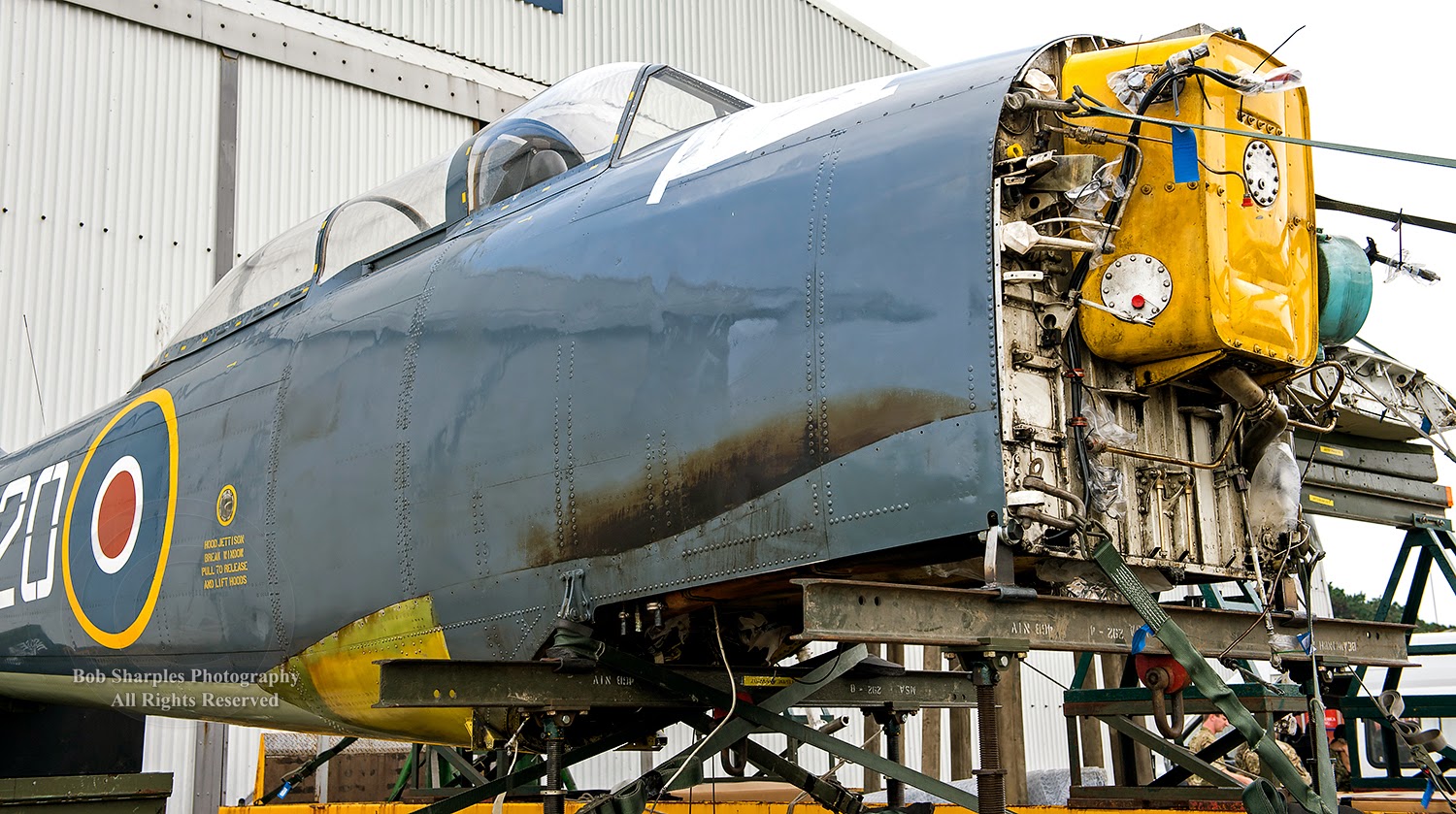On a seperate note: wildlife photography will hopefullly resume in a couple of weeks. Been a busy summer doing Aviation related stuff and a couple of exhibitions, couple with a lot of DIY catching up at home. A week in Wales next week for low level aircraft photography then I hope to get some wildlife/night photography in.
Ok now onto the Royal Navy Sea Fury images and a press release at the end from the Fly Navy Heritage Trust:
OUTSTANDING SUPPORT FOR SEA FURY RECOVERY
The historic Royal Navy Sea Fury T20 G-RNHF (VX281) that suffered engine
failure during a display manoeuvre at RNAS Culdrose Air Day on 31 July 2014,
forcing the pilot to take swift action and make an emergency landing, will be transported
from RNAS Culdrose, Cornwall to Weald Aviation Services, North Weald Airfield
in Epping, Essex, on 24 September 2014 for full assessment and repair.
The undercarriage of the iconic Hawker fighter collapsed on landing and
the aircraft skidded off the runway and onto the grass, sustaining only minimal
damage due to the quick thinking and skilled airmanship of the pilot,
Lieutenant Commander Chris Götke Royal Navy. With the main focus of the
investigation centred on the aircraft’s Bristol Centaurus eighteen-cylinder
radial engine, the engine and propeller were removed from the aircraft shortly
after the incident and taken by road to North Weald - and now the airframe is
to follow.
The move will be carried out by the Joint Aircraft Recovery and
Transportation Squadron (JARTS), a specialist unit dedicated to aircraft
post-crash management, recovery and transportation. In preparation for the recovery,
the unit has been working together with air engineering teams from RNAS
Culdrose and Weald Aviation to partially strip down the large fighter in order
to reduce the width of the load for the journey through the narrow Cornish
lanes. The fuselage, centre wing section and the two outer wings will travel as
three separate loads on specially adapted transporters to ensure that the rare
heritage aircraft is well protected and incurs no further damage during the
move.
Designed in the 1940s, the Sea Fury was one of the most successful and
popular aircraft ever operated by the post war Fleet Air Arm, proving
particularly capable in intensive carrier operations during the Korean War in
the early 1950s.
The aircraft, which is one of the last airworthy survivors of the 50s
era is owned by the Fly Navy Heritage Trust, the Royal Navy charity that
preserves and promotes the Nation’s Naval Aviation Heritage. Over the past
three years Sea Fury T20 G-RNHF has attracted great excitement at air shows and
events up and down the country thrilling audiences with the power, grace and
high performance of this ultimate piston-engine fighter.
Speaking of the support the Fly Navy Heritage Trust has received from the
Royal Navy and the military generally, Captain Mike Nixon OBE, Chief Executive
of the Trust, said “The co-operation and support we have received from RNAS
Culdrose, Weald Aviation, JARTS, 814 Naval Air Squadron and the scientists,
naval engineers and civilian specialists in 1710 Naval Air Squadron has been
absolutely outstanding.”
“The aircraft recovery team at RNAS Culdrose, particularly Lieutenant
Commander Dale Collins Royal Navy, Senior Aircraft Engineer (Fixed Wing)
Aviation Force HQ has been exceptional” continued Mike Nixon.
“We are also greatly indebted to the team from JARTS for their
specialist expertise and professionalism. It has been an incredible example of
the Royal Navy, civilian engineers, the wider military and the charitable trust
all working together. I cannot praise
highly enough, the dedication, care and devotion shown by everyone involved in the
recovery of this rare and precious heritage aircraft.”
Fran Renouf, Weald Aviation’s Deputy Chief Engineer said “It has been a
rare and privileged opportunity for everyone to work on such a magnificent
heritage aircraft. Because it is something different, it has been interesting
and everyone has really enjoyed doing it. People have loaned equipment and
others have made bespoke trestles and bolts to support the airframe – nothing
has been too much trouble.”
“The blacksmith at RNAS Culdrose, Ian Mack, made special brackets to
secure the fuselage to one of the low loaders” continued Fran. “As this sort of
equipment is no longer made anymore they found a drawing in an old aviation
publication and made something to fit. It was old engineering skills at its
best! Many visitors also came to see the aircraft and the whole RNAS Culdrose
community could not have been more supportive of one of the Royal Navy’s
historically significant heritage aircraft. The team spirit and ‘can do’
approach has been marvellous!”
“The Sea Fury incident has provided some unusual opportunities for those
involved in her recovery to test and demonstrate their professional skills”
said Rear Admiral Ian Tibbitt CBE, Deputy Chairman of the Fly Navy Heritage
Trust. “All the renowned Fleet Air Arm engineering skills of problem solving,
adaptability and innovation have been to the fore and the results reflect an
outstanding achievement. The Trust is extremely grateful and all involved can
be justifiably proud.”
The route for the ‘Convoie Exceptionnel’ has been carefully researched and
the journey to North Weald, which will include an overnight stop, is expected
to take about 8 hours.






No comments:
Post a Comment